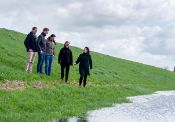Dyke reinforcement Wolferen Sprok

Dyke reinforcement Wolferen Sprok
The Waaldijk between Wolferen and Sprok, near Nijmegen, is being reinforced as part of the national Flood Protection Programme (HWBP). Rivierenland Water Board commissioned landscape architects from Witteveen+Bos, working in partnership with Bureau Stroom, to draw up an experiential value survey and a spatial quality framework for the 13.1-kilometre dyke.
Participatory process
Water safety can only be improved if the reinforcement solution is understood and accepted by local community stakeholders. To engage them in the 'story of the dyke', the Water Board gets them involved in the process at an early stage. The spatial quality framework adds substance to this.
In a community-based participatory process, an area analysis was performed. Various discussions and meetings were also organised with those involved. A study was conducted into the most important features and core qualities of this dyke trajectory. A spatial vision was then drawn up and developed into design principles, attention points and ambitions for retaining and strengthening the spatial quality of the dyke reinforcement.

The success of this project lay in the integrated approach of the spatial quality framework, the experiential value survey and the participatory/communication process. The experiential value survey is one of the building blocks for the spatial quality framework. This ensures that the experiential values are concretised and, along with more factual information, translated into principles for the dyke reinforcement.
The experiential value survey is integrated into the participatory process, boosting support from residents for the quality framework. The conclusions from various conditioning surveys were also included in the quality framework.
Through this approach, the substance of the framework is acknowledged and recognised by local people, experts in landscape, nature and cultural history and the policy advisors involved. As such, the spatial quality framework becomes a tool to communicate with the local residents and not purely a landscape architectonic study.
More information?






